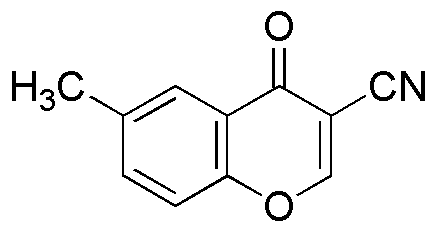3-Cyano-6-methylchromone is widely utilized in research focused on:
- Pharmaceutical Development: This compound serves as a key intermediate in the synthesis of various pharmaceuticals, particularly those targeting neurological disorders, due to its ability to modulate neurotransmitter activity.
- Fluorescent Probes: Its unique structure allows it to be used in the development of fluorescent probes for biological imaging, aiding researchers in visualizing cellular processes in real-time.
- Antioxidant Formulations: The compound exhibits significant antioxidant properties, making it valuable in cosmetic formulations aimed at reducing oxidative stress on the skin.
- Agricultural Chemicals: It is applied in the formulation of agrochemicals, enhancing plant growth and resistance to pests, which is crucial for sustainable agriculture practices.
- Material Science: 3-Cyano-6-methylchromone is explored for its potential in creating advanced materials, such as polymers and coatings, that require specific optical properties.
General Information
Properties
Safety and Regulations
Applications
3-Cyano-6-methylchromone is widely utilized in research focused on:
- Pharmaceutical Development: This compound serves as a key intermediate in the synthesis of various pharmaceuticals, particularly those targeting neurological disorders, due to its ability to modulate neurotransmitter activity.
- Fluorescent Probes: Its unique structure allows it to be used in the development of fluorescent probes for biological imaging, aiding researchers in visualizing cellular processes in real-time.
- Antioxidant Formulations: The compound exhibits significant antioxidant properties, making it valuable in cosmetic formulations aimed at reducing oxidative stress on the skin.
- Agricultural Chemicals: It is applied in the formulation of agrochemicals, enhancing plant growth and resistance to pests, which is crucial for sustainable agriculture practices.
- Material Science: 3-Cyano-6-methylchromone is explored for its potential in creating advanced materials, such as polymers and coatings, that require specific optical properties.
Documents
Safety Data Sheets (SDS)
The SDS provides comprehensive safety information on handling, storage, and disposal of the product.
Product Specification (PS)
The PS provides a comprehensive breakdown of the product’s properties, including chemical composition, physical state, purity, and storage requirements. It also details acceptable quality ranges and the product's intended applications.
Certificates of Analysis (COA)
Search for Certificates of Analysis (COA) by entering the products Lot Number. Lot and Batch Numbers can be found on a product’s label following the words ‘Lot’ or ‘Batch’.
*Catalog Number
*Lot Number
Certificates Of Origin (COO)
This COO confirms the country where the product was manufactured, and also details the materials and components used in it and whether it is derived from natural, synthetic, or other specific sources. This certificate may be required for customs, trade, and regulatory compliance.
*Catalog Number
*Lot Number
Safety Data Sheets (SDS)
The SDS provides comprehensive safety information on handling, storage, and disposal of the product.
DownloadProduct Specification (PS)
The PS provides a comprehensive breakdown of the product’s properties, including chemical composition, physical state, purity, and storage requirements. It also details acceptable quality ranges and the product's intended applications.
DownloadCertificates of Analysis (COA)
Search for Certificates of Analysis (COA) by entering the products Lot Number. Lot and Batch Numbers can be found on a product’s label following the words ‘Lot’ or ‘Batch’.
*Catalog Number
*Lot Number
Certificates Of Origin (COO)
This COO confirms the country where the product was manufactured, and also details the materials and components used in it and whether it is derived from natural, synthetic, or other specific sources. This certificate may be required for customs, trade, and regulatory compliance.


